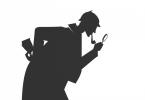Relatively recently, in 2010, the traffic rules were supplemented by the requirement that the movement of vehicles is allowed only with the headlights on. It is important for the driver to know not only the nuances of these requirements, but also to remember the punishment for their violation.
Dear readers! Our articles talk about typical ways solutions legal issues but each case is unique.
If you want to know how to solve exactly your problem - contact the online consultant form on the right.
Or call us at number:
8 804 333 71 85 (Toll free)
It's fast and free!
Requirements for driving with lights
So, when is it legal to turn your headlights on and off? The requirements are quite simple. They are set out in the 19th chapter of the SDA. Here the subtleties of using various automotive lighting devices are considered. AT in general terms the requirements are as follows:
- When moving through tunnels, as well as in case of poor visibility on the street (due to darkness, for another reason), it is necessary to turn on the near or high beam.
- It is necessary to turn off the main beam when driving through illuminated settlements. And also - if there are oncoming cars, regardless of the place, especially if there is a danger of blinding the driver.
- If visibility is poor and the car is stationary, at least turn on the parking lights. Additionally, you can indicate your presence with the help of fog lights, low beams.
- Fog lights turn on when needed.
- Even when it is light, the car must turn on either daytime running lights or dipped beam while driving.
- Special requirements are imposed on the use of a special headlight - a searchlight or a searchlight. The ban applies to switching on in populated areas and in the presence of oncoming traffic. Exceptions apply only to special vehicles.
- If visibility is poor, rear fog lamps may be used. However, they should not be connected to brake lights.
- In cases with the movement of a road train, it is necessary to include a special identification sign.
The fifth item on the list caused some criticism. Dissatisfied car owners said that because of the innovation, the cost of fuel and headlight bulbs would jump. Calculations, however, showed that careless driving (even without an accident) is much more expensive.
In addition, before the innovation, the turn-on time car headlights was somewhat subjective. During the period of light twilight, many drivers believed that it was still (already) light enough. The requirement for constantly on headlights eliminated such subjectivity, and the number of accidents of this kind decreased.
And now let's find out what the penalty is for not turning on the dipped headlights.
Penalty for not turning on headlights
So, is there any and what for driving without dipped beam day and night? Those who do not comply with the requirements of the 19th chapter of the SDA should be punished. Article 12.20 of the Code of Administrative Offenses is devoted to this issue.
Regardless of what kind of violation in the field of using car lights the driver made, he will face administrative responsibility. The punishment may be a warning or a fine of 500 rubles. All this is true if no accident occurred on the road due to driving with the headlights off.
We will talk about the fine for a burned-out and inoperative dipped beam bulb below.
This video will tell you how to act when stopping for driving without headlights:
Non-working lighting fixtures
This situation is very common, but still sometimes contradictory. Is it the driver's fault that the headlight does not work due to a blown bulb? In general, no, but here it is useful to remember the requirements of traffic rules.
- For example, paragraph 2.3.1 requires checking the car's serviceability, including whether the headlights work. Faulty - can not go. If the headlights fail en route, repairs should be made as soon as possible.
- In addition, the SDA has an appendix on the approval of the vehicle for operation. The third part is devoted to the work of lighting devices. Clause 3.3. indicates: if the headlights do not work, or at least are simply dirty, then driving on such a car is prohibited.
Penalties for a faulty headlight will be under Article 12.5 of the Code of Administrative Offenses, in the first part. True, the punishment will not change from this - all the same warning or 500 rubles fine if the low beam headlight does not work.
Let's imagine a situation: a car has recently got into an accident, the consequences are relatively small, but the headlight has stopped burning. What to do if the inspector stopped with claims on the way to the car service? It is necessary to calmly explain the situation and, if possible, present evidence. For example, photo and/or video recording of an accident. AT similar situations it is quite possible to count on the understanding of the traffic police officer.
However, subsequently you need to put the headlights in order as soon as possible. If this issue is not resolved quickly enough, the violation will already be evident.
Changes in traffic rules allowed cars to become more visible when driving. This measure has markedly improved road safety, as has the measure
The correct use of lights is one of the arts that every driver must master. It would be simple if the driver had only a couple of headlights in the arsenal, but there are many more of them, as well as conditions that require the use of lights. certain type. But if you study all the subtleties of the issue well, then very soon you will hone your skill in the correct use of backlighting.
What regulates the inclusion of headlights on the road
The signaling system is a kind of car "language" with which the driver can communicate with other participants. traffic. Lighting devices are only part of this complex “communication” mechanism, but every driver must know all the rules and subtleties of their use.
 And before you figure out when to turn on the headlights, let's list all the lighting devices available in the driver's arsenal. Modern cars have 8 external lighting fixtures.
These include:
And before you figure out when to turn on the headlights, let's list all the lighting devices available in the driver's arsenal. Modern cars have 8 external lighting fixtures.
These include:
low beam headlights;
high beam headlights;
Rear lights;
Parking lights;
Fog lights (PTF);
Rear PTF;
Daytime Running Lights;
Rear license plate light.
Of these eight devices, we are interested in the first seven, the last one does not participate in automobile traffic.
Lighting devices must be switched on between dusk and dawn. Flashlights and headlights can also be used at other times of the day, in conditions of limited visibility due to weather conditions. Snowfall, storm, rain and fog, which caught the driver on the road, oblige him to turn on the lighting, otherwise, at best, the car owner will be fined for not turning on the headlights, and at worst, he risks personal safety.
Important! Before you get behind the wheel, be sure to check the correct operation of all lighting devices.
Rules for using headlights on a car
But isn't it a lot - seven working illuminators for one car? No, not much, but just right. Each of these types of headlights has its own purpose and its specific use. Consider ordinary cases when the ability to properly use lighting fixtures plays a particularly important role.
 Despite the obvious meaning of the term "dark time of the day", each driver can interpret it in his own way. Therefore, the rules of the road give a clear explanation of what period of time is involved.
Despite the obvious meaning of the term "dark time of the day", each driver can interpret it in his own way. Therefore, the rules of the road give a clear explanation of what period of time is involved.
According to the traffic rules, nighttime is the period from evening twilight to sunrise. Therefore, with the advent of darkness and until dawn, the driver on the road must turn on the light.
Namely:
dipped or main beam headlights (with some exceptions, which are discussed below);
Marker lights on vehicles with trailers and towed vehicles;
When stopping at the side of the road or in a parking lot, the parking lights must also be turned on.
After dark, you can not turn on:
Fog lights (including rear ones) on illuminated roads or unlit, not including low / high beam headlights;
High beam headlights if:
- the road is illuminated;
The car is driving through the city;
The oncoming vehicle is at a distance of less than 150 m;
It is possible to blind the driver.
Daytime running lights, according to the rules of the SDA, are also prohibited at night.
Did you know? The rules of the road spell out the color of daylight allowed for use running lights: DHF installed on the front of the car must be white color. The use of headlights with a slight yellow or bluish tint is allowed.
Poor visibility conditions
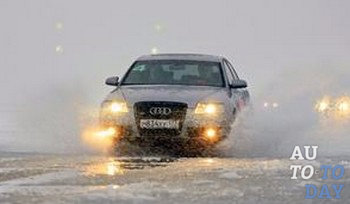 Fog, snow, rain, and other natural or weather phenomena that limit the visual range to 300 m are considered conditions of insufficient visibility. In this case, the rules for using lighting devices are the same as in the dark (turn on high / low beam, parking lights) , plus a few specific rules:
Fog, snow, rain, and other natural or weather phenomena that limit the visual range to 300 m are considered conditions of insufficient visibility. In this case, the rules for using lighting devices are the same as in the dark (turn on high / low beam, parking lights) , plus a few specific rules:
1. Fog lights (PTF) are used on roads of any illumination.
2. PTFs are turned on together with the high and low beam headlights.
3. During fog, the rear PTFs must also work.
Tunnels are also considered to be places with insufficient visibility. Concerning traffic rules, then the regulations for the use of lighting devices in tunnels are the same as in the dark.
If everything is clear with the rules for using lighting devices at night, then the question remains: is it necessary to turn on the dipped and main beam during the day?
According to the decree of the government of the Russian Federation, since 2010 there has been a rule obliging drivers to drive with the low beam headlights on both during the day and at night.
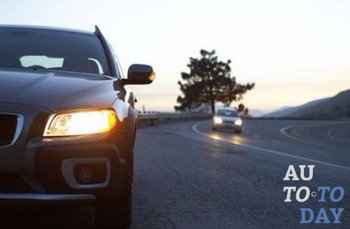 With regard to driving outside the built-up area, the driver must drive with the main beam headlights on, even on a lighted road. If another car is driving towards you, then the high beam must be switched to low beam so as not to blind the driver.
With regard to driving outside the built-up area, the driver must drive with the main beam headlights on, even on a lighted road. If another car is driving towards you, then the high beam must be switched to low beam so as not to blind the driver.
Provided that there are no cars within a radius of 300 meters, outside the settlement it is allowed to use a spotlight and a searchlight for its intended purpose.
Did you know? In advanced European countries, car headlights are on 24 hours a day, 365 days a year. The energy consumption is colossal, but it is generated by the car itself, so the driver loses practically nothing from a financial point of view.
For many, it seems strange to use lighting fixtures during the day, but for personal safety, this rule should not be neglected.
Penalty for not turning on the dipped headlights
So, we have already found out whether it is necessary to turn on the headlights during the day in the city, now it’s worth talking about what will happen if this is not done. Driving with the dipped headlights off is considered an administrative offense, because the correct use of lighting devices is a safety issue. In this case, the traffic police inspector has the right to issue a fine of 500 rubles. If a car moving with headlights off becomes a victim of an accident, then both sides bear the administrative penalty - the culprit and the victim.
Important! A fine is not the most serious punishment for not turning on the headlights. If an accident occurs due to a driver who did not turn on the headlights, then the person responsible for the accident may be deprived of their rights.
What is the penalty if the headlight does not work
A fine can be issued even if one dipped beam headlight does not light due to a breakdown or does not burn brightly enough. A car with faulty headlights is not allowed to enter the roadway. Therefore, before you hit the road, you need to check all the signaling systems, and only after making sure that they work properly, get behind the wheel.
There are many subtleties and conditions in the rules of the road. But by “playing by the rules,” you minimize the likelihood of unwanted accidents on the road.
Subscribe to our feeds
Since November 20, 2010, every driver moving on the carriageway must turn on the dipped headlights. At one time, such an innovation was accepted very negatively and caused a lot of controversy, but it showed its usefulness - with the low beam turned on, it is much easier to notice the car and quickly determine its dimensions. This is useful for both pedestrians and drivers.
This rule always applies: the dipped beam must be turned on both during the day and at night, in foggy and clear weather. At the same time, driving without dipped beam is a violation, although not too serious. At the same time, driving during the day with the dipped beam turned off or not on is one of the few types of violations associated with the improper use of lighting devices.
In what cases can a driver be fined for incorrect lighting?
- Daytime running lights not on. As mentioned above, each driver must only drive with the lights on. daylight;
- Improper use of high beam. Be aware that using high beams can dazzle other road users. Therefore, riding with him in any settlements is prohibited;
- Using the rear fog lights inappropriately. Rear "foglights" - additional device, and their use, subject to sufficient visibility, can be regarded as an offense;
- Use only running lights at night. If the car is equipped with running lights, then their use in the dark is considered insufficient - the dipped beam must be turned on;
- Light fixtures are not up to standard. If your headlights do not meet at least one of the GOST parameters, then their use can be considered a violation of traffic rules.
Penalty for driving without dipped beam
If during the movement the light was not turned on (for example, the driver simply forgot about it), then, according to Article 12.20 of the Code of Administrative Offenses, a fine will be issued, the amount of which is five hundred rubles. In practice, this penalty is rarely issued, as driving with headlights off is most often treated as a collateral infraction. Therefore, most often for driving without lighting, the driver receives only a warning.
Pay the fine online:
Penalty for using high beam
When driving outside the settlement, the driver can use the high beam at his own discretion - driving with it is regulated only by the norms of driver ethics. However, as soon as the driver enters the settlement, driving with the light becomes a violation of the punishable Code of Administrative Offenses. The amount of the fine is five hundred rudders.
Penalty for incorrect use of "rear foglights"
Although such a violation exists in the Code of Administrative Offenses, most often they are not fined for it - the driver is simply given a warning. However, if the fine is still issued, then its size will be only five hundred rubles.
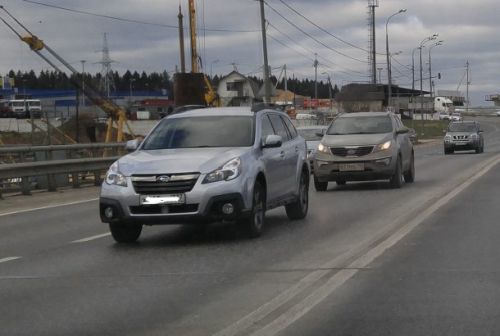
The most controversial of all types of fines for driving with the wrong use of low beams. The problem in determining its size is that between the Code of Administrative Offenses and the rules of the road. SDA is much more loyal to drivers and allows movement with inoperative headlights if the movement is carried out to a car service in order to repair this headlight. But the Code of Administrative Offenses, on the contrary, is strict, and considers that a violation is a violation, and a fine for driving with a broken light should be issued in any case. In practice, everything depends on the opinion of the inspector and the experience of the driver. The amount of the fine for driving with non-working devices in this case is five hundred rubles..
Installing red lights
If you decide to install a red dipped beam on your car, then you will have a very severe a fine of three thousand rubles. This size is due to the fact that driving with low beam headlights disorients other drivers and contributes more to the occurrence of an accident. The same fine is issued for the installation of other lighting devices that interfere with normal traffic.
What requirements does the traffic police put forward for low beam devices and running lights?
A large number of drivers are trying to replace the lights on their cars for aesthetic purposes or to better lighting. This is not prohibited by law, but there is a special set of rules governing the installation of LED lights. They set the following standards
- The distance from the lights to the ground is not less than twenty-five centimeters, but not more than one and a half meters;
- The distance between the lights themselves should not be less than sixty centimeters;
- The distance from the lights to the bumper should not exceed forty centimeters;
- Allowed following colors: white, yellow, orange. The red color is strictly prohibited - its installation is considered a serious violation of traffic rules;
- The area of the radiating surface should not be more than twenty-five square centimeters
- The lighting intensity should correspond to the range of 400 - 800 Cd.
Summing up
Riding with the light even in daytime— the rule is useful and effective. However, the light itself must be used wisely. If you interfere with other drivers with bright illumination, you can become the culprit of an accident. At the same time, the consequences will be much more serious, and it will no longer be possible to get off with a fine of 500 rubles. Therefore, it is necessary to correctly regulate the lighting own transport and think not only about yourself, but also about other road users.
The non-included dipped beam is one of the most common causes stop cars by traffic police officers.
Traffic rules restrict the use of cars with off lights. It does not matter whether such devices are installed on the car at all, whether they are in good condition or not.
A few years ago, significant changes were made to the rules of the road, according to which all drivers of vehicles can only travel with dipped headlights, fog lights or running lights. As the traffic police say, the movement of a car with the lights on makes it more noticeable on the roads and in settlements, regardless of the time of day.
Penalty for not turning on the low beam
Most drivers do not attach importance to the importance of such a requirement of traffic rules and do not turn on the dipped beam when they start driving their car. In some cases, the lack of dipped beam may be the cause of a malfunction of lighting fixtures or wiring.
The rules of the road clearly state that driving on city roads and highways without dipped beam is on is prohibited. In its absence, the driver is held liable:
- In the form of an official warning from a traffic police officer.
- In the form of a fine of 500 rubles.
If traffic police officers notice a car on the road without lights on, they have the right to stop it.
Most motorists agree that it is possible to drive with the fog lights on, without turning on the low beam. According to the rules of the road, such headlights can be used instead of low beam during daylight hours, as they also allow you to detect a car and make it more noticeable on the road.
The stop of the car can also be in the case when the switching on of the dipped headlights was made in the visibility zone of the vehicle by the traffic police. In this case, the driver will get off with a warning.
It is the task of the owner of the car to check the serviceability of daylight before each start of movement by car. Driving with position lights is prohibited unless they are switched on together with other lights.
 Responsibility for the partial inclusion of dipped headlights
Responsibility for the partial inclusion of dipped headlights
There are cases when a driver drives a car on which one dipped beam headlight or one of the running lights is broken. At the same time, the second headlight is in working condition and turned on.
Despite all the explanations of the person driving the vehicle, the traffic police officer who noticed such a car will still issue him a decision to bring him to administrative responsibility in the form of a fine of 500 rubles. The reason for such a fine will not be a violation of the rules for operating the vehicle, but a violation of the requirements contained in the list of malfunctions.
There are practically no differences between such grounds, however, in such a situation, the driver more possibilities receive not a fine, but a verbal warning.
As a rule, traffic police officers issue a fine for such a violation if the car is moving in conditions of poor visibility or at night.
The traffic police officer can offer the driver the following options Troubleshooting:
- On-site replacement. If it takes only five minutes to fix the problem, the traffic inspector cannot issue a ticket. For example, if the car burned out anti-fog headlight, the driver can drive the vehicle with the dipped headlights on. In this case, the malfunction will be eliminated, and the owner of the car will not receive a decision to impose a fine.
- If the driver manages to correctly convey to the inspector the reason why one of his headlights does not light up, he can be released to the place of troubleshooting. For example, if the lamp burned out already in the process of driving and the owner of the car does not have a spare lamp to replace it, he can proceed to the place of repair. In such a situation, no penalty is issued.
- Drawing up a protocol and bringing the driver to administrative responsibility. If the traffic police officer began to draw up a protocol, but the driver does not agree with it, he may not put his signature on this document. In addition, the driver is entitled for 10 days.
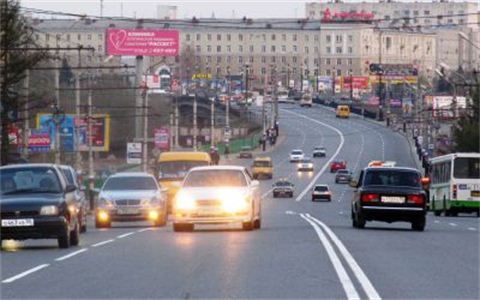 High beam penalty
High beam penalty
Is it possible to travel with high beam during the day? Most drivers, especially those who often travel outside settlements, do not attach much importance to this and always drive their car with high beams on.
Meanwhile, the rules of the road provide for the requirement that driving in locality using distant lighting is prohibited.
If traffic police officers stop a vehicle with high-beam headlights on on an illuminated city road, the person driving the car will be held administratively liable in the form of a fine of 500 rubles.
What can be evidence of a crime?
The principle of the presumption of innocence operates in Russian administrative legislation. In accordance with this principle, traffic police officers must prove that the person stopped by them violated the requirements of the law. The driver does not have to prove his innocence.
To prove that the person driving the vehicle actually committed a punishable act, traffic police officers must present visual evidence:
- Photography.
- Video filming.
- Witness testimony.
If the traffic inspectorate does not have any evidence, all doubts are interpreted in favor of the person driving the car. That is why the driver needs to carefully look at what exactly the policeman writes in the protocol and not put his signature on this document if he has a vision of what happened.
The same applies to witnesses, to whom police officers rarely explain the situation and simply ask them to sign an already completed protocol.
Judicial practice shows that judges always take the side of the traffic police, ignoring evidence from the driver. So it is better to take care in advance to indicate at the time of drawing up the protocol that the situation was described incorrectly.
 If the person driving the vehicle does not have any claims against the traffic police, and he does not want to appeal the decision to prosecute, the driver can. This can be done after 10 days from the date of receipt of the decision in any way convenient for the person.
If the person driving the vehicle does not have any claims against the traffic police, and he does not want to appeal the decision to prosecute, the driver can. This can be done after 10 days from the date of receipt of the decision in any way convenient for the person.
If the driver does not pay the fine within two months, they can be taken against him.
In order not to prove your innocence and not pay fines, it is necessary to check the serviceability of the lighting system of your car before each departure.

